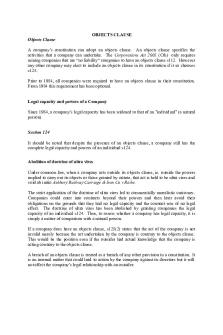Referencing - Extra notes PDF

| Title | Referencing - Extra notes |
|---|---|
| Course | Public Relations Strategy |
| Institution | Murdoch University |
| Pages | 1 |
| File Size | 72.8 KB |
| File Type | |
| Total Downloads | 116 |
| Total Views | 164 |
Summary
Extra notes...
Description
Referencing Students undertaking PR units at Murdoch University have been asked to use either APA or Chicago referencing. Please refer to the Murdoch University Library’s tips on how to correctly use the different types of references http://library.murdoch.edu.au/Students/Referencing/
Why you cite and reference your sources “When academics write... they not only present their idea but also refer to the ideas of other academics. This means they need a way to distinguish between their own ideas and the ideas of other people” (Brick, 2006, p. 98).
Systems used to reference your work There are two common ways of referencing used in academia and at Murdoch University to tell the reader of your essay or report the sources of your information or ideas. These are
Author - Date citations within the text, such as (Marshall & Rowland, 2006), with the complete referencing details in an alphabetically arranged reference list at the end of the document. Note that in-text citations use only the surname(s) of the author(s), the date of publication, and the page number (if necessary).
Numbering citations using numbers either in a superscript1or in brackets (1) within the text, with the complete referencing details as a footnote at the foot of the page or in endnotes at the end of the document. Note that both footnotes and endnotes have the option of an additional comment or notes about the particular source.
Using sources in your text Perhaps one of the best ways to learn how and what to reference, quote and paraphrase is to pay careful attention to what you read in your units. This material has usually been through a thorough process of drafting and editing and would not be published if it failed to demonstrate all of the conventions of sound academic writing for that particular discipline. Over time you will start to notice how these authors structure arguments, use transitions and connectives and introduce quotes. For example, you may notice that authors frequently use a range of introductions such as the following:
Smith’s point is that… Smith’s point of view is that… According to Smith,… From Smith’s point of view… The point of Smith’s article/paper is that... The substance of Smith’s article/paper is that… Some theorists, such as Smith (1989) think that… It is thought by some theorists, for example, Jones (1980) and Smith (1989), that…...
Similar Free PDFs

Referencing - Extra notes
- 1 Pages

Referencing Styles - notes
- 3 Pages

APA Referencing - Lecture notes 1
- 37 Pages

Extra Google computing notes
- 9 Pages

Extra Credit Notes - Peterson
- 2 Pages

Harvard Referencing
- 8 Pages

Referencing Guide
- 15 Pages

Extra
- 29 Pages

Extra
- 8 Pages

Canon Law Marriage - Extra notes
- 18 Pages

Extra Notes on Objects Clause
- 1 Pages

EPE extra - Lecture notes 1,2
- 9 Pages

Extra Notes on Objects Clause
- 1 Pages

Extra - Food - Lecture notes 18
- 1 Pages

Harvard citation hlp - referencing
- 68 Pages
Popular Institutions
- Tinajero National High School - Annex
- Politeknik Caltex Riau
- Yokohama City University
- SGT University
- University of Al-Qadisiyah
- Divine Word College of Vigan
- Techniek College Rotterdam
- Universidade de Santiago
- Universiti Teknologi MARA Cawangan Johor Kampus Pasir Gudang
- Poltekkes Kemenkes Yogyakarta
- Baguio City National High School
- Colegio san marcos
- preparatoria uno
- Centro de Bachillerato Tecnológico Industrial y de Servicios No. 107
- Dalian Maritime University
- Quang Trung Secondary School
- Colegio Tecnológico en Informática
- Corporación Regional de Educación Superior
- Grupo CEDVA
- Dar Al Uloom University
- Centro de Estudios Preuniversitarios de la Universidad Nacional de Ingeniería
- 上智大学
- Aakash International School, Nuna Majara
- San Felipe Neri Catholic School
- Kang Chiao International School - New Taipei City
- Misamis Occidental National High School
- Institución Educativa Escuela Normal Juan Ladrilleros
- Kolehiyo ng Pantukan
- Batanes State College
- Instituto Continental
- Sekolah Menengah Kejuruan Kesehatan Kaltara (Tarakan)
- Colegio de La Inmaculada Concepcion - Cebu
